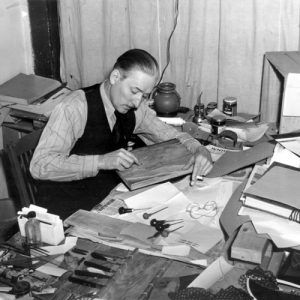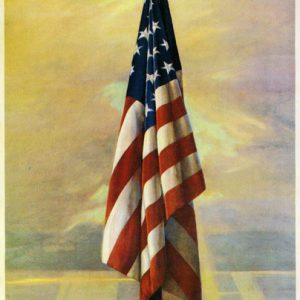calsfoundation@cals.org
Sentinel of Freedom
The most famous painting by Arkansas artist Adrian Louis Brewer (1891–1956), the 1941 “Sentinel of Freedom” has been reproduced millions of times and has received wide distribution in America and abroad. Several million reproductions of the painting were distributed to schools, churches, and individuals during World War II, and the painting has become a staple of modern culture.
The painting was commissioned by Little Rock (Pulaski County) insurance executive Clyde E. Lowry. Lowry was acquainted with Brewer’s work as a combat artist who painted wartime posters and more during World War I. Lowry wanted a painting depicting “the beauty of the flag when the wind had died down and the gentle folds took their natural place.”
At the time, Brewer was painting commissioned portraits of various Arkansas elites and was initially reluctant to accept the commission. He had painted many American flags during his years as a combat artist, but they had all been incorporated in the scenes of battles, never standing alone as the central figure of the painting. After accepting the commission, he decided to make the flag the focal point of a traditional landscape. The oil painting that resulted depicts the American flag hanging loosely on a flagpole, which is perched on top of the Boston Mountains of Arkansas, overlooking a background of the sky covered in orange and pink clouds. Rays of sunshine breaking through the bottoms of the clouds, giving the flag an ethereal appearance.
The popularity of the painting was due in part to the dichotomy of a peaceful, airy landscape with the restful, dignified, peacetime flag versus the strong feelings of patriotism usually evoked by the American flag.
The painting was unveiled in Washington DC in a ceremony attended by many members of Congress, the judiciary, ambassadors, and other dignitaries and citizens. Admiral Harold R. Stark, then chief of naval operations, was present at the unveiling and expressed the hope that the painting would someday be displayed permanently at the U.S. Naval Academy.
Under the direction of Lowry, the American Company of Little Rock, a printing company, issued several thousand embossed prints of “Sentinel of Freedom.” The prints were embossed, treated, framed, and sold for $3.00. Part of the inscription on the back of the frame of the embossed prints read: “The Sentinel of Freedom stands guard over the homes of 130 million people. Though not visible from every threshold, its presence is ever felt. The blue of the mountains, the sparkle of the river, and the golden rays of the sun lend beauty and elegance to this gentle but determined master of American destiny.”
The separate branches of the armed forces distributed the prints through their ranks. Ships that went to sea during World War II carried a print on board, and USOs had a print hung in their halls; it also hung in Congressman Brooks Hays’s office in Washington DC. A print of the flag hung in many classrooms throughout Arkansas. Lowry received several thousand letters concerning the painting and thousands of requests for reproductions of it from such notables as automobile manufacturer Henry Ford, poet Edward A. Guest, former president Herbert Hoover, Republican presidential candidate Wendell Willkie, and General George W. Marshall. After the unveiling, it toured Washington DC in the 1940s, and Brewer autographed the prints being sold. The original finally ended up in what is now the Arkansas Museum of Fine Arts, where it remained for several years. Lowry and Edwina Brewer, wife of Adrian Brewer, along with their families, presented the original to the U.S. Naval Academy, Assembly Hall Library, in Annapolis, Maryland, on March 1, 1964, where it is still displayed.
The picture occasionally can be seen in movies and television shows. It was visible in the 1990 movie Beverly Hills Cop II and on the ABC sitcom Spin City in Michael J. Fox’s office.
For additional information:
“Famed painting by LR Artist to be Gift to Naval Academy.” Arkansas Gazette, February 18, 1964.
Fletcher, John L. “Adrian Brewer—The Portrait of an Artist.” Arkansas Gazette, January 11, 1953.
Halinksi, Jolynda Hammock. “Adrian Louis Brewer (1891–1956): Visions of an Arkansas Painter.” MA thesis, University of Arkansas at Little Rock, 1997.
Jolynda Hammock Halinski
Vicksburg, Mississippi
 Arts, Culture, and Entertainment
Arts, Culture, and Entertainment Adrian Brewer
Adrian Brewer  Sentinel of Freedom
Sentinel of Freedom 



My great-grandfather (Clyde E. Lowry) told me about this painting just before he died. He was in Texarkana and sitting in a diner having lunch on a drive home to Little Rock from Texas when he saw a print of one of Brewer’s WWI flags on a wall calendar. Already acquainted with Brewer’s work, he decided then that he would pursue the painting. When I started first grade, he sent a framed copy of the Sentinel of Freedom to the school for my classroom. On more than one occasion, I have read through the scrapbooks of letters he received from dignitaries, politicians, business leaders, and others. The most moving are the letters from schoolchildren either commenting on having the picture in their classrooms or asking him to send one. To my knowledge, he never failed to have a copy sent to anyone who asked for one. Over the years, he commissioned Brewer to paint at least three other portraits: one of my father as a teenager, my grandfather during his naval service, and the portrait of my great-grandfather Clyde and his wife, Olive D. Lowry, which still hangs at the Lowry Blood Center of the American Red Cross.